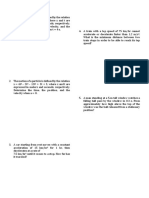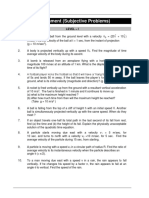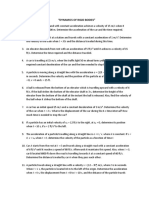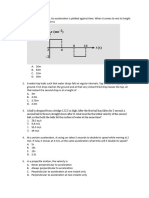0 ratings0% found this document useful (0 votes)
54 viewsProblem Set Part 1 Answer
These problems involve calculating position, velocity, acceleration, and other kinematic properties of objects in motion under constant acceleration or along curved paths. The problems require setting up and solving equations of motion to determine values at given times or other conditions such as maximum height or impact point.
Uploaded by
Vince MarananCopyright
© © All Rights Reserved
Available Formats
Download as DOCX, PDF, TXT or read online on Scribd
0 ratings0% found this document useful (0 votes)
54 viewsProblem Set Part 1 Answer
These problems involve calculating position, velocity, acceleration, and other kinematic properties of objects in motion under constant acceleration or along curved paths. The problems require setting up and solving equations of motion to determine values at given times or other conditions such as maximum height or impact point.
Uploaded by
Vince MarananCopyright
© © All Rights Reserved
Available Formats
Download as DOCX, PDF, TXT or read online on Scribd
You are on page 1/ 17
1. The motion of a particle is defined by the relation x=1.
5 t 4−30 t 2 +5 t+10, where x
and t are expressed in meters and seconds, respectively. Determine the position,
the velocity, and the acceleration of the particle when t=4 s .
2. The motion of a particle is defined by the relation x=12 t 3 −18 t 2 +2 t+5 , where x
and t are expressed in meters and seconds, respectively. Determine the position
and the velocity when the acceleration of the particle is equal to zero.
3. On a certain stretch of track, trains run at 60 mph. How far back of a stopped train should warning torpedo is placed to
ft
signal an oncoming train? Assume that the brakes are applied at once and retard the train at the uniform rate of 2 2 .
s
4. An automobile starting from rest speeds up to 40 ft per sec with a constant
acceleration of 4 ft per sec², runs at this speed for a time, and finally comes to rest
with a deceleration of 5 ft per sec². If the total distance travelled is 1000 ft, find the
total time required.
5. An automobile is moving at a constant velocity of 45 ft per sec passes a gasoline
station. Two seconds later, another automobile leaves the gasoline station and
accelerates at the constant rate of 6 ft/s². How soon will the second automobile
overtake the first?
6. The car in the figure moves in a straight line such that for a short time its velocity is
ft
defined by v=( 3 t +2 t ) , where t is in seconds. Determine its position and acceleration
2
s
when t=3 s . When t=0 , s=0.
7. A ball is dropped from the top of a tower 80 ft high at the same instant that a second
ball is thrown upward from the ground with an initial velocity of 40 ft/s. When and where
do they pass, and with what relative velocity?
8. During a test, a rocket travels upward at 75 m/s, and when it is 40 m from the ground
its engine fails. Determine the maximum height reached by the rocket and its speed just
before it hits the ground. While in motion, the rocket is subjected to a constant
downward acceleration of 9.81 m/s² due to gravity. Neglect the effect of air resistance.
9. A stone is dropped down a well and 5 s later the sound of the splash is heard. If the
velocity of the sound is 1120 ft/s, what is the depth of the well?
10. Pin A, which is attached to link AB, is constrained to move in the circular slot CD.
Knowing that at t=0 the pin starts from rest and moves so that its speed increases at
a constant rate of 0.8 in/s2, determine the magnitude of its total acceleration when (a)
t=0, (b) t=2 s
11. A particle moves on a circle in accordance with the equations s=t 4 −8 t , where s is
the displacement in feet measured along the circular path and t is in seconds. Two
seconds after starting from rest, the total acceleration of the particle is 48 √ 2 ft/s².
12. A team of engineering students designs a medium-size catapult which launches 8-lb
steel spheres. The launch speed is V o = 80 ft/sec, the launch angle is ɵ= 35 degrees
above the horizontal, and the launch position is 6 ft above ground level. The students
use an athletic field with an adjoining slope topped by an 8-ft fence as shown.
Determine:
(a) the x-y coordinates of the point of first impact
(b) the time duration of the flight
(c) the maximum height h above the horizontal field attained by the ball
13. The pilot of an airplane carrying a package of mail to a remote outpost wishes to
release the package at the right moment to hit the recovery location A. What angle theta
with the horizontal should the pilot's line of sight to the target make at the instant of
release? The airplane is flying horizontally at an altitude of 100 m with a velocity of 200
km/h.
14. A shell leaves a mortar with a muzzle velocity of 150 m/sec. directed upward at 60
deg. with the horizontal. Determine the position of the shell and its resultant velocity 20
sec. after firing. How high will it rise?
15. Determine the speed at which the basketball at A must be thrown at an angle of 30
degrees so that it makes it to the basket B.
You might also like
- Kinematics Subjective Problems-SP-NPJC I-Jun 13No ratings yetKinematics Subjective Problems-SP-NPJC I-Jun 1311 pages
- Chapter 4-Motion in Two Dimensions: Multiple Choice100% (1)Chapter 4-Motion in Two Dimensions: Multiple Choice18 pages
- XI-Pysics CH-3 Motion in a Straight Line Sheet - S. L. ARORA (2023-'24)-4No ratings yetXI-Pysics CH-3 Motion in a Straight Line Sheet - S. L. ARORA (2023-'24)-410 pages
- Engineering Mechanics and Strength of MaterialsNo ratings yetEngineering Mechanics and Strength of Materials9 pages
- Problem Set (Projectile&Curvilinear Motion)No ratings yetProblem Set (Projectile&Curvilinear Motion)2 pages
- Applications of Derivatives Rate of Change (Calculus) Mathematics Question BankFrom EverandApplications of Derivatives Rate of Change (Calculus) Mathematics Question BankNo ratings yet
- Siwes Report (Ime Industrial Maintenance Engineering) - 063225No ratings yetSiwes Report (Ime Industrial Maintenance Engineering) - 06322520 pages
- Class Schedule Sy 2021 2022 Senior High SchoolNo ratings yetClass Schedule Sy 2021 2022 Senior High School2 pages
- Q2 - M2 - Current and Future Trends in Media and InformationNo ratings yetQ2 - M2 - Current and Future Trends in Media and Information32 pages
- Tackling Disablist Language Based Bullying in School: A Teacher's GuideNo ratings yetTackling Disablist Language Based Bullying in School: A Teacher's Guide28 pages
- ISO 15189 Accreditation: Benita I.Haines Corporate Compliance and Quality Manager For Valley Health July 19, 2009No ratings yetISO 15189 Accreditation: Benita I.Haines Corporate Compliance and Quality Manager For Valley Health July 19, 200915 pages
- GE BDD 15 & BDD 16 Testing Notes Not Inclusive.: General ConnectionsNo ratings yetGE BDD 15 & BDD 16 Testing Notes Not Inclusive.: General Connections2 pages
- H.K. Moffatt - Cosmic Dynamos: From Alpha To OmegaNo ratings yetH.K. Moffatt - Cosmic Dynamos: From Alpha To Omega5 pages
- BMU Titan Cradle: Standard Features Control BoxNo ratings yetBMU Titan Cradle: Standard Features Control Box2 pages
- Customer Perception Towards Chinese Mobile Brands in Indian Market With Special Reference To Cuddalore DistrictNo ratings yetCustomer Perception Towards Chinese Mobile Brands in Indian Market With Special Reference To Cuddalore District97 pages
- Participatory Action Research Literature Review100% (1)Participatory Action Research Literature Review7 pages
- SDET Bottles Filling and Capping Machine Operation ManualNo ratings yetSDET Bottles Filling and Capping Machine Operation Manual10 pages
- General Questions For Interview: Q1: Tell Me About YourselfNo ratings yetGeneral Questions For Interview: Q1: Tell Me About Yourself5 pages
- Chapter 4-Motion in Two Dimensions: Multiple ChoiceChapter 4-Motion in Two Dimensions: Multiple Choice
- XI-Pysics CH-3 Motion in a Straight Line Sheet - S. L. ARORA (2023-'24)-4XI-Pysics CH-3 Motion in a Straight Line Sheet - S. L. ARORA (2023-'24)-4
- Applications of Derivatives Rate of Change (Calculus) Mathematics Question BankFrom EverandApplications of Derivatives Rate of Change (Calculus) Mathematics Question Bank
- A Complete Course in Physics (Graphs) - First EditionFrom EverandA Complete Course in Physics (Graphs) - First Edition
- Simple Definition And Explanation Of Force In PhysicsFrom EverandSimple Definition And Explanation Of Force In Physics
- Siwes Report (Ime Industrial Maintenance Engineering) - 063225Siwes Report (Ime Industrial Maintenance Engineering) - 063225
- Q2 - M2 - Current and Future Trends in Media and InformationQ2 - M2 - Current and Future Trends in Media and Information
- Tackling Disablist Language Based Bullying in School: A Teacher's GuideTackling Disablist Language Based Bullying in School: A Teacher's Guide
- ISO 15189 Accreditation: Benita I.Haines Corporate Compliance and Quality Manager For Valley Health July 19, 2009ISO 15189 Accreditation: Benita I.Haines Corporate Compliance and Quality Manager For Valley Health July 19, 2009
- GE BDD 15 & BDD 16 Testing Notes Not Inclusive.: General ConnectionsGE BDD 15 & BDD 16 Testing Notes Not Inclusive.: General Connections
- H.K. Moffatt - Cosmic Dynamos: From Alpha To OmegaH.K. Moffatt - Cosmic Dynamos: From Alpha To Omega
- Customer Perception Towards Chinese Mobile Brands in Indian Market With Special Reference To Cuddalore DistrictCustomer Perception Towards Chinese Mobile Brands in Indian Market With Special Reference To Cuddalore District
- SDET Bottles Filling and Capping Machine Operation ManualSDET Bottles Filling and Capping Machine Operation Manual
- General Questions For Interview: Q1: Tell Me About YourselfGeneral Questions For Interview: Q1: Tell Me About Yourself

























































































